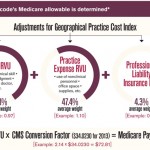For the fourth time in the past 15 years, a rheumatologist will hold a two-year voting seat on the American Medical Association’s Relative Value Update Committee (RUC), which advises the Centers for Medicare & Medicaid Services (CMS) about setting its Medicare reimbursement rates for physician services—rates that also heavily influence private payer reimbursement rates.

Dr. Barré
The new member of the RUC is Luke Barré, MD, MPH, RhMSUS, a rheumatologist with Hawthorn Medical Associates in Dartmouth, Mass., and assistant professor of clinical medicine at Boston University School of Medicine.
“The RUC provides a structured, data-driven way of ensuring that our physician work is appropriately valued, which ultimately impacts reimbursement and equitable patient care,” Dr. Barré says. “That’s important to medicine overall, and it’s important to our specialty, our patients and the sustainability of our field.”
Representing Rheumatology
In all, the RUC comprises fewer than three dozen seats, which are assigned to different medical fields. Internal medicine holds a seat that can be filled by a representative of several specialty societies, including the ACR, according to Antanya Chung, ACR’s director of practice management, who helps ensure that rheumatology is represented on the RUC.
“This seat is the only seat the ACR can ever hold on the RUC panel, and we are excited for Dr. Barré to be elected to this important position,” Ms. Chung says. “He is a very intelligent and caring professional who is humble and considerate. We appreciate the significant amount of time and dedication that he gives to this process, rheumatology and to medicine, especially with a young family.”
As a RUC member, Dr. Barré will evaluate and vote on payment codes that are outside his area of expertise, a RUC protocol designed to eliminate bias in its recommendations to the CMS. However, many of these codes can be relevant to rheumatology services as well.
His alternate is rheumatologist Tim Laing, MD, MACR, associate professor emeritus at the University of Michigan Medical Center, who has served three previous two-year terms as a RUC member. A third rheumatologist, Eileen M. Moynihan, MD, FACP, FACRH, of Noridian Healthcare Solutions, has served in RUC capacities in the past and will hold a post as the ACR’s RUC advisor. As a non-voting advisor, Dr. Moynihan will directly advocate on behalf of rheumatology by presenting to the RUC both the results of ACR member surveys (see sidebar) and ACR recommendations about physician valuation.
Dedicated Work
Before becoming a RUC member, Dr. Barré held the position of RUC advisor trainee. “He learned a lot as a trainee, and we were delighted when he expressed a desire to continue on,” says Dr. Laing. “As I become more and more age-challenged, shall we say, it’s become increasingly important to have somebody who can go forward on the RUC because it’s a very detail-oriented process, and it takes a while to not only learn it, but also feel confident that you understand all the nuances of it.”
The committee meets three times per year to discuss and vote on payment code recommendations. For those meetings, which last four to five days each, members receive assigned subsets of payment codes to evaluate. They must gather information from societies and their surveys, practitioners and other sources and present concise but comprehensive assessments to the RUC for a vote, explains Ms. Chung. In this way, the RUC presents the CMS with fact-based consensus recommendations.
Despite the time commitment—up to 15 days in the RUC meetings, not to mention long hours learning about the broad range of physician services and procedures and writing code evaluations—Dr. Barré feels his decision to participate on the RUC is the right one. “I think it comes down to recognizing that somebody has to do it,” he says. “Somebody has to advocate for patient access and equitable patient care, and some of that comes down ultimately to making sure that the care can be sustainably delivered. And that means being at the table.”
Besides that, he remarks, “I get to be surrounded by leaders from all these other specialty societies. I am forming natural relationships with people from other specialties. These are people who have similar interests and are also interested in understanding how we can work together to accomplish shared goals.”
A Collective Voice
Dr. Laing has a similar perspective about serving on the RUC, which he described as “building the house of medicine.” He explains, “One reason to have rheumatology involved in the RUC is to help out with a large effort that benefits all of us: creating a system that appropriately values medical procedures and services. So, by agreeing to participate as a society, we’re basically saying we are willing to take our place in that altruistic effort.”
At the same time, participation also benefits the field of rheumatology, Dr. Barré says. Often, codes are shared across specialties, so although members do not vote on their own payment codes, they collaborate with others who also use rheumatology codes, examine different societies’ survey results, discuss codes with society advisors and help frame the collective views on rheumatology codes that are ultimately presented to the RUC for a vote. “These codes touch every single rheumatologist and therefore every single patient who enters the rheumatologist’s office, so we need to be represented on the RUC,” he says.
Dr. Laing adds, “Without participation in the RUC process, the only avenue available for expressing your concern over evaluation of a code is to meet with or write directly to the CMS. In other words, you are an individual voice instead of a collective voice, and the collective voice is much more powerful in terms of obtaining a value that you think fairly represents what you do. That’s really what it comes down to. And that’s why we need to be part of the RUC.”
The ACR asks rheumatologists to join or renew membership in the AMA so this work may continue. Rheumatology’s ability to be involved in AMA committees and the AMA House of Delegates is dependent upon enough ACR members also being members of the AMA, so every single person who is a member of both the ACR and the AMA is helping with these efforts. Visit the AMA’s membership site to join or renew your AMA membership and receive valuable membership benefits along with helping to advance rheumatology.
Leslie Mertz, PhD, is a freelance science journalist based in northern Michigan.
Help yourself and your patients: Fill out the RUC survey!
To have a say in CMS reimbursement rates, fill out your RUC surveys. That is the plea from rheumatologists serving on the American Medical Association’s Relative Value Update Committee (RUC). The RUC heavily relies on the surveys to make its case to the CMS about appropriate valuation for physician services and procedures.
“RUC surveys are not like the ubiquitous surveys that you get from a store or website customer service that probably never go anywhere or do anything. The RUC surveys really do matter,” says RUC member and rheumatologist Luke Barré, MD, MPH, RhMSUS.
When a CMS code comes up for reevaluation or initial evaluation, each affected professional society, including the ACR, sends out a RUC survey to its members. “The survey participation rate, which varies depending on the code’s use by each society’s members, is scrutinized carefully by the RUC to determine its validity,” explains RUC member and rheumatologist Tim Laing, MD, MACR. “If we don’t meet that threshold, the RUC will deem the survey results unreliable, and our opinions won’t count.”
Dr. Barré adds, “Everybody gets survey fatigue, but a RUC survey is one where filling it out—and filling it out honestly—is ultimately going to impact your bottom line. With the RUC survey, the difference of a few people responding or not responding can make the difference in getting an appropriate CMS reimbursement code. So, yes, filling out these surveys really matters.”
For more information on the RUC survey process, application of relative value units or how to become involved in this area, contact the ACR staff liaison Antanya Chung at [email protected].

